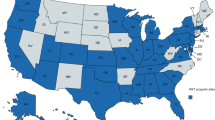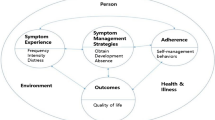Abstract
Little is known about the psychological burden patients are left with after successful allogeneic hematopoietic SCT (HSCT). With the main focus on physical condition and common transplant complications, psychological symptoms often remain neglected in daily practice. To assess the prevalence of distress in patients who have undergone allogeneic HSCT, we conducted a cross-sectional pilot study in 50 consecutive patients from our outpatient transplant clinic using standardized questionnaires. Distress was categorized by symptoms of anxiety, fear of progression, depression and post-traumatic stress disorder (PTSD). Forty-one patients completed self-administered questionnaires. The median age was 53 years (21–74 years) and the mean time after transplantation was 614 days (25–2070 days). In total, 18 patients (44%) showed symptoms of distress. Among these 18 patients, 11 patients reported symptoms of anxiety, 12 patients suffered from fear of progression, 11 patients showed symptoms of depression and 6 patients of PTSD. Age below 55 years was significantly associated with fear of progression (P=0.004). This study demonstrates the high prevalence of distress in patients who have undergone allogeneic HSCT. Our results suggest an unmet need for professional support and intervention. These findings may be relevant as distress could have an influence on the outcome after HSCT.
This is a preview of subscription content, access via your institution
Access options
Subscribe to this journal
Receive 12 print issues and online access
$259.00 per year
only $21.58 per issue
Buy this article
- Purchase on Springer Link
- Instant access to full article PDF
Prices may be subject to local taxes which are calculated during checkout
Similar content being viewed by others
References
Armitage JO . Bone marrow transplantation. N Engl J Med 1994; 330: 827–838.
Appelbaum FR . The current status of hematopoietic cell transplantation. Annu Rev Med 2003; 54: 491–512.
Sullivan KM . Current status of bone marrow transplantation. Transplant Proc 1989; 21 (Suppl 1): 41–50.
Baldomero H, Gratwohl M, Gratwohl A, Tichelli A, Niederwieser D, Madrigal A et al. The EBMT activity survey 2009: trends over the past 5 years. Bone Marrow Transplant 2011; 46: 485–501.
Passweg JR, Baldomero H, Gratwohl A, Bregni M, Cesaro S, Dreger P et al. The EBMT activity survey: 1990–2010. Bone Marrow Transplant 2012; 47: 906–923.
Bearman SI, Appelbaum FR, Buckner CD, Petersen FB, Fisher LD, Clift RA et al. Regimen-related toxicity in patients undergoing bone marrow transplantation. J Clin Oncol 1988; 6: 1562–1568.
Barrett AJ, Savani BN . Stem cell transplantation with reduced-intensity conditioning regimens: a review of ten years experience with new transplant concepts and new therapeutic agents. Leukemia 2006; 20: 1661–1672.
Passweg JR, Baldomero H, Bregni M, Cesaro S, Dreger P, Duarte RF et al. Hematopoietic SCT in Europe: data and trends in 2011. Bone Marrow Transplant 2013; 48: 1161–1167.
Harousseau JL . Role of stem cell transplantation. Hematol Oncol Clin N Am 2007; 21: 1157–1174.
Prieto JM, Blanch J, Atala J, Carreras E, Rovira M, Cirera E et al. Psychiatric morbidity and impact on hospital length of stay among hematologic cancer patients receiving stem-cell transplantation. J Clin Oncol 2002; 20: 1907–1917.
Holland JC . NCCN practice guidelines for the management of psychosocial distress. National Comprehensive Cancer Network. Oncology (Williston Park) 1999; 13: 113–147.
Jim HS, Syrjala KL, Rizzo D . Supportive care of hematopoietic cell transplant patients. Biol Blood Marrow Transplant 2012; 18 (Suppl): S12–S16.
Mosher CE, Redd WH, Rini CM, Burkhalter JE, DuHamel KN . Physical, psychological, and social sequelae following hematopoietic stem cell transplantation: a review of the literature. Psycho-Oncology 2009; 18: 113–127.
Syrjala KL, Langer SL, Abrams JR, Storer B, Sanders JE, Flowers ME et al. Recovery and long-term function after hematopoietic cell transplantation for leukemia or lymphoma. JAMA 2004; 291: 2335–2343.
Prieto JM, Atala J, Blanch J, Carreras E, Rovira M, Cirera E et al. Patient-rated emotional and physical functioning among hematologic cancer patients during hospitalization for stem-cell transplantation. Bone Marrow Transplant 2005; 35: 307–314.
Lee SJ, Loberiza FR, Antin JH, Kirkpatrick T, Prokop L, Alyea EP et al. Routine screening for psychosocial distress following hematopoietic stem cell transplantation. Bone Marrow Transplant 2005; 35: 77–83.
DuHamel KN, Ostrof J, Ashman T, Winkel G, Mundy EA, Keane TM et al. Construct validity of the posttraumatic stress disorder checklist in cancer survivors: analyses based on two samples. Psychol Assess 2004; 16: 255–266.
Jacobsen PB, Sadler IJ, Booth-Jones M, Soety E, Weitzner MA, Fields KK . Predictors of posttraumatic stress disorder symptomatology following bone marrow transplantation for cancer. J Consult Clin Psychol 2002; 70: 235–240.
Widows MR, Jacobsen PB, Fields KK . Relation of psychological vulnerability factors to posttraumatic stress disorder symptomatology in bone marrow transplant recipients. Psychosom Med 2000; 62: 873–882.
Smith MY, Redd W, DuHamel K, Vickberg SJ, Ricketts P . Validation of the PTSD Checklist-Civilian Version in survivors of bone marrow transplantation. J Trauma Stress 1999; 12: 485–499.
Spitzer RL, Kroenke K, Williams JB, Lowe B . A brief measure for assessing generalized anxiety disorder: the GAD-7. Arch Intern Med 2006; 166: 1092–1097.
Lowe B, Decker O, Muller S, Brahler E, Schellberg D, Herzog W et al. Validation and standardization of the Generalized Anxiety Disorder Screener (GAD-7) in the general population. Med Care 2008; 46: 266–274.
Mehnert A, Herschbach P, Berg P, Henrich G, Koch U . Fear of progression in breast cancer patients—validation of the short form of the Fear of Progression Questionnaire (FoP-Q-SF). Z Psychosom Med Psychother 2006; 52: 274–288.
Herschbach P, Berg P, Dankert A, Duran G, Engst-Hastreiter U, Waadt S et al. Fear of progression in chronic diseases: psychometric properties of the Fear of Progression Questionnaire. J Psychosom Res 2005; 58: 505–511.
Spitzer RL, Kroenke K, Williams JB . Validation and utility of a self-report version of PRIME-MD: the PHQ primary care study. Primary Care Evaluation of Mental Disorders. Patient Health Questionnaire. JAMA 1999; 282: 1737–1744.
Lowe B, Kroenke K, Herzog W, Grafe K . Measuring depression outcome with a brief self-report instrument: sensitivity to change of the Patient Health Questionnaire (PHQ-9). J Affect Disord 2004; 81: 61–66.
Kroenke K, Spitzer RL, Williams JB . The PHQ-9: validity of a brief depression severity measure. J Gen Intern Med 2001; 16: 606–613.
National Center for PTSD Boston, MA, USA: Posttraumatic Stress Disorder Checklist (PCL), published 1993 in International Society for Traumatic Stress Studies: http://www.istss.org/PosttraumaticStressDisorderChecklist/5361.htm.
Ruggiero KJ, Del Ben K, Scotti JR, Rabalais AE . Psychometric properties of the PTSD Checklist-Civilian Version. J Trauma Stress 2003; 16: 495–502.
Blanchard EB, Jones-Alexander J, Buckley TC, Forneris CA . Psychometric properties of the PTSD Checklist (PCL). Behav Res Ther 1996; 34: 669–673.
Deck R, Röckelein E . Zur Erhebung soziodemographischer und sozialmedizinischer Indikatoren in den rehabilitationswissenschaftlichen Forschungsverbünden. DRV-Schriften 1999; 16: 84–102.
Zabora J, BrintzenhofeSzoc K, Curbow B, Hooker C, Piantadosi S . The prevalence of psychological distress by cancer site. Psycho-Oncology 2001; 10: 19–28.
Carlson LE, Angen M, Cullum J, Goodey E, Koopmans J, Lamont L et al. High levels of untreated distress and fatigue in cancer patients. Br J Cancer 2004; 90: 2297–2304.
Hoodin F, Zhao L, Carey J, Levine JE, Kitko C . Impact of psychological screening on routine outpatient care of hematopoietic cell transplantation survivors. Biol Blood Marrow Transplant 2013; 19: 1493–1497.
Sun CL, Francisco L, Baker KS, Weisdorf DJ, Forman SJ, Bhatia S . Adverse psychological outcomes in long-term survivors of hematopoietic cell transplantation: a report from the Bone Marrow Transplant Survivor Study (BMTSS). Blood 2011; 118: 4723–4731.
Prieto JM, Atala J, Blanch J, Carreras E, Rovira M, Cirera E et al. Role of depression as a predictor of mortality among cancer patients after stem-cell transplantation. J Clin Oncol 2005; 23: 6063–6071.
Loberiza FR Jr., Rizzo JD, Bredeson CN, Antin JH, Horowitz MM, Weeks JC et al. Association of depressive syndrome and early deaths among patients after stem-cell transplantation for malignant diseases. J Clin Oncol 2002; 20: 2118–2126.
Colon EA, Callies AL, Popkin MK, McGlave PB . Depressed mood and other variables related to bone marrow transplantation survival in acute leukemia. Psychosomatics 1991; 32: 420–425.
Park JE, Kim KI, Yoon SS, Hahm BJ, Lee SM, Yoon JH et al. Psychological distress as a negative survival factor for patients with hematologic malignancies who underwent allogeneic hematopoietic stem cell transplantation. Pharmacotherapy 2010; 30: 1239–1246.
McGregor BA, Syrjala KL, Dolan ED, Langer SL, Redman M . The effect of pre-transplant distress on immune reconstitution among adult autologous hematopoietic cell transplantation patients. Brain Behav Immun 2013; 30 (Suppl): S142–S148.
Acknowledgements
We thank our patients participating in this study. Results have been presented at the annual meeting of the German, Austrian and Swiss Society of Hematology and Oncology (DÖSGHO) in Vienna in October 2013. This paper contains results of the inaugural dissertation of Astrid Dannenmann and Katharina Drebinger. We also thank Judy Peng, PhD, for critical reading of the manuscript.
Author information
Authors and Affiliations
Corresponding author
Ethics declarations
Competing interests
The authors declare no conflict of interest.
Rights and permissions
About this article
Cite this article
Hefner, J., Kapp, M., Drebinger, K. et al. High prevalence of distress in patients after allogeneic hematopoietic SCT: Fear of progression is associated with a younger age. Bone Marrow Transplant 49, 581–584 (2014). https://doi.org/10.1038/bmt.2013.228
Received:
Revised:
Accepted:
Published:
Issue Date:
DOI: https://doi.org/10.1038/bmt.2013.228
Keywords
This article is cited by
-
Effect of family cohesion on symptom distress during hematopoietic stem cell transplantation
Supportive Care in Cancer (2022)
-
What is known about palliative care in adult patients with allogeneic stem cell transplantation (allo-SCT)?
Annals of Hematology (2021)
-
Engaging hematopoietic cell transplantation patients and caregivers in the design of print and mobile application individualized survivorship care plan tools
Supportive Care in Cancer (2020)
-
Trauma- and stressor-related disorders among hematological cancer patients with and without stem cell transplantation: protocol of an interview-based study according to updated diagnostic criteria
BMC Cancer (2019)
-
Psychosocial risk predicts high readmission rates for hematopoietic cell transplant recipients
Bone Marrow Transplantation (2018)



